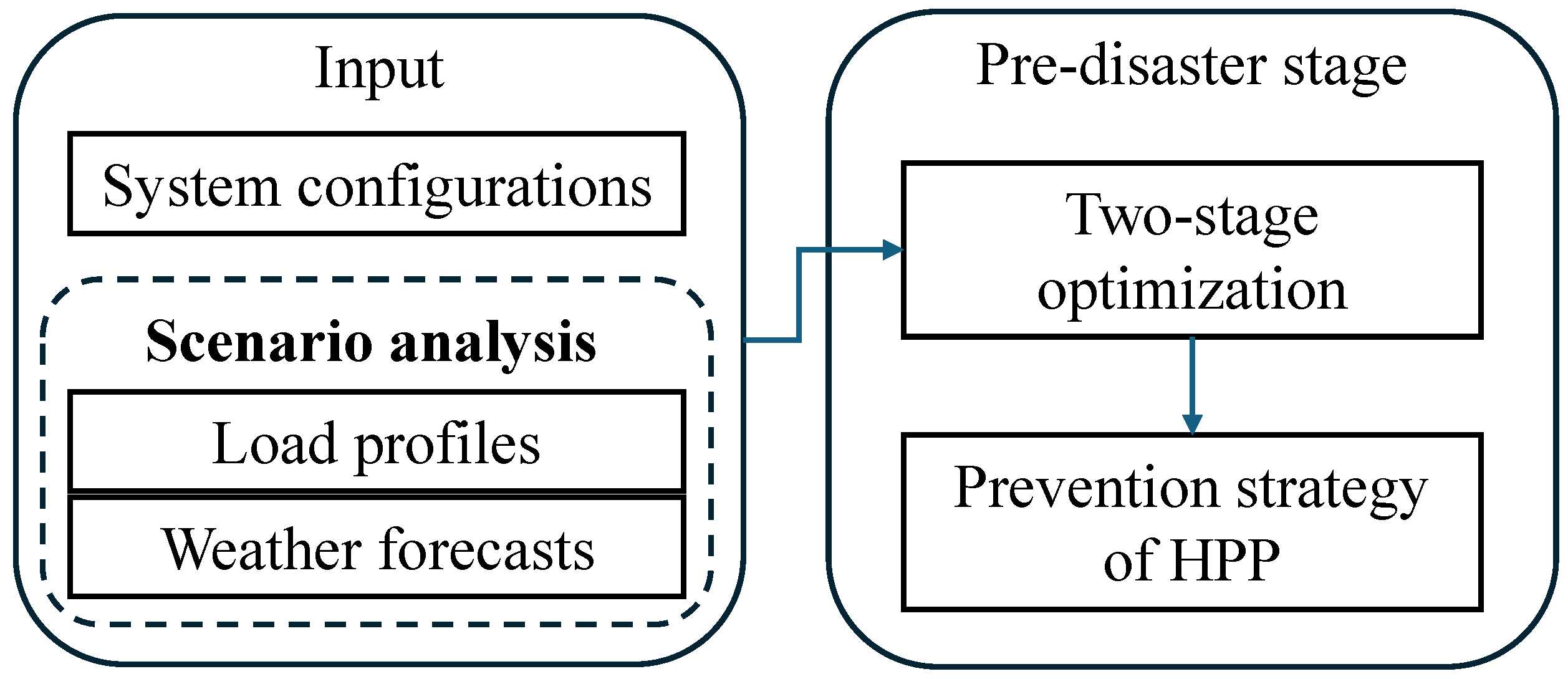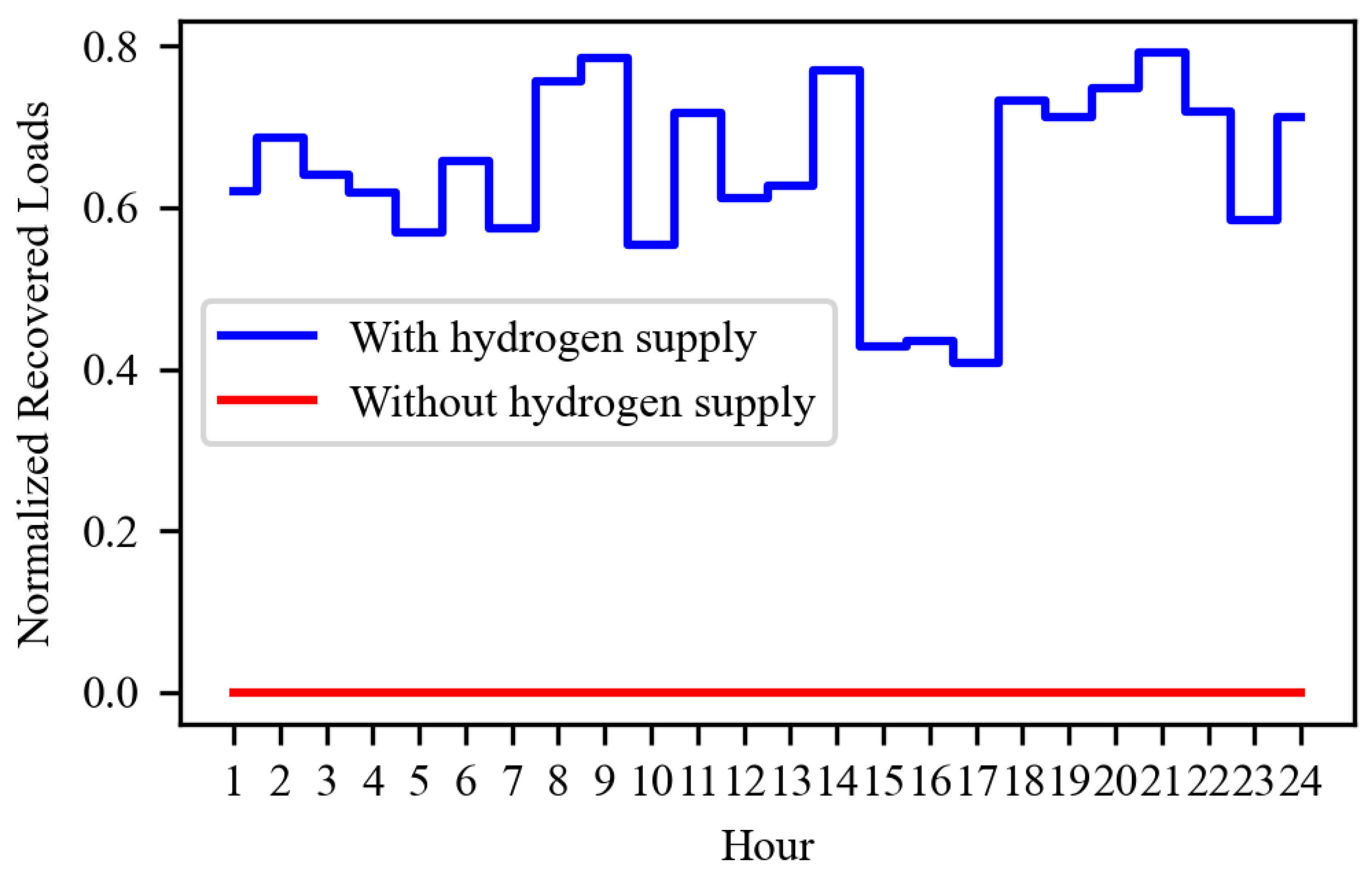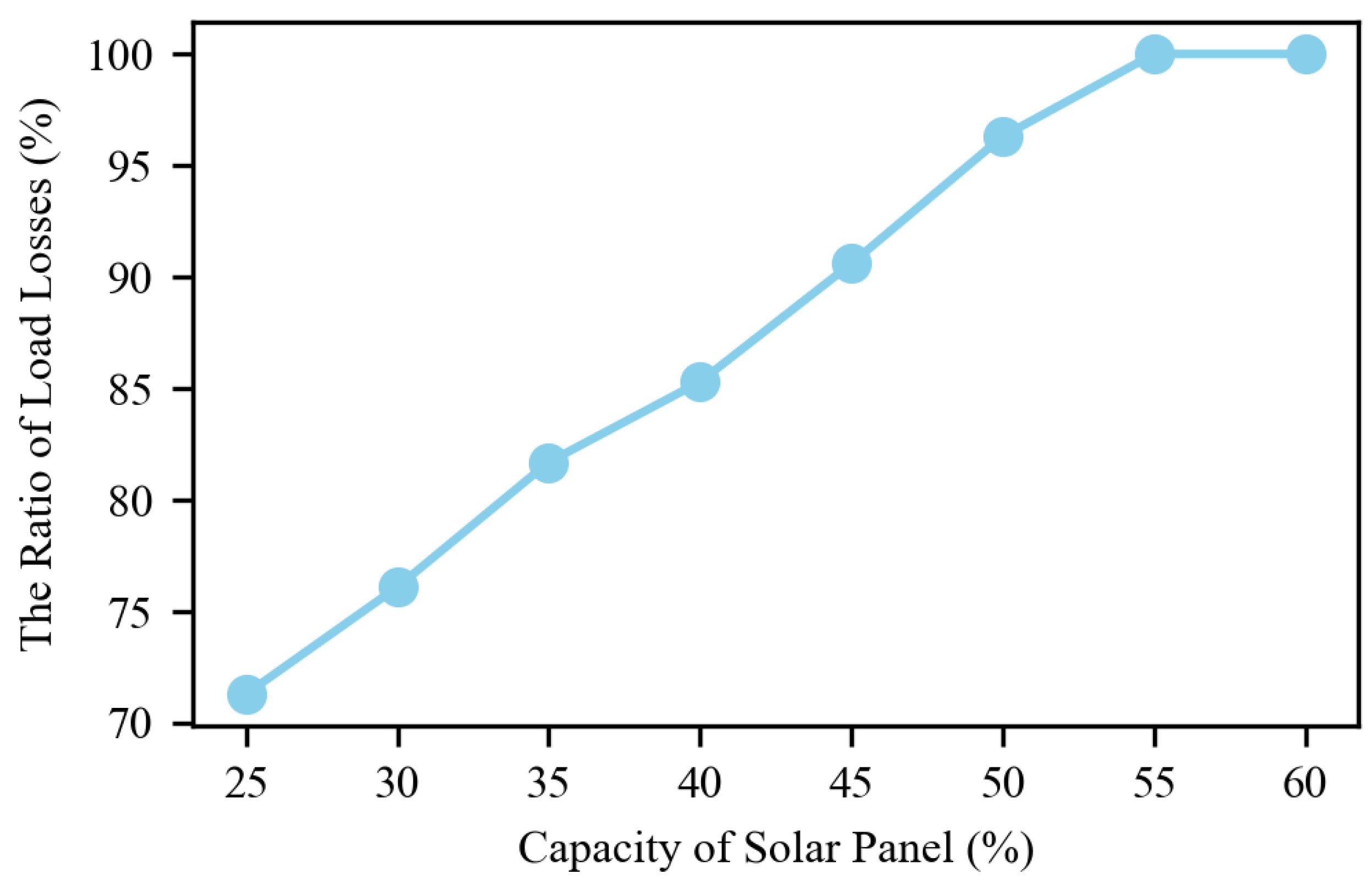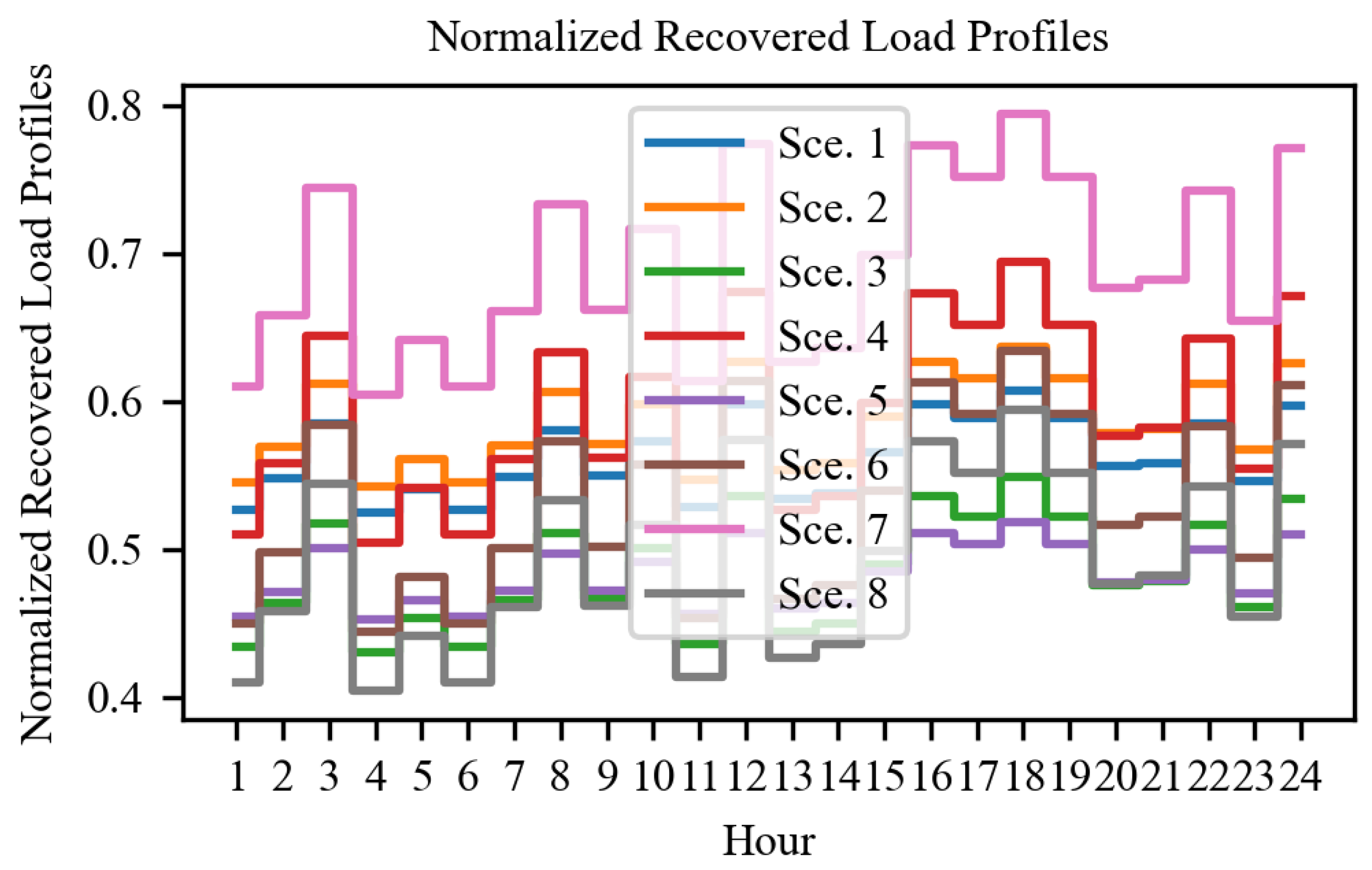Pre-Disaster Optimal Operation Strategy for Hydrogen-Fuel-Based Isolated Power System with Disaster Uncertainties
Abstract
1. Introduction
1.1. Motivation
1.2. Literature Review
1.3. Contributions
- There is a scarcity of research focusing specifically on pre-disaster preventive scheduling using hydrogen production in power networks.
- The application of stochastic optimization in pre-disaster scenarios, particularly for hydrogen-based systems, is not adequately explored.
- Most current research on power system resilience is focused on real-time response strategies, with less emphasis on pre-emptive measures that can be taken before a disaster strikes.
- Our study addresses this by developing strategies for pre-disaster hydrogen production at HPPs. We focus on creating a buffer of renewable energy storage, which is crucial for maintaining power supply during emergencies.
- We introduce an innovative approach using a two-stage stochastic optimization model tailored to pre-disaster planning. This model factors in the unpredictability of disaster scenarios and optimizes hydrogen production and storage in anticipation of potential power disruptions.
- Our research fills this gap by integrating advanced technologies and predictive methods to formulate a comprehensive pre-disaster scheduling strategy. This proactive approach is designed to bolster the power network’s resilience, ensuring efficient energy distribution and preparedness for extreme weather events.
2. Problem Description
2.1. Pre-Disaster Operation
2.2. Load/Renewable Forecasting and Clustering
2.3. Two-Stage Stochastic Optimization
3. Mathematical Model
3.1. Hydrogen Production and Consumption Model
3.1.1. Electrolyzer Operation
3.1.2. Fuel Cell Model
3.1.3. Hydrogen Storage
3.2. Energy Balance Model
3.2.1. Topology Constraints
3.2.2. Load Constraints
3.2.3. Capacity Limitations
3.2.4. Overall Model
4. Data-Driven Scenario Reduction
4.1. Scenario Generation
4.2. Scenario Reduction
| Algorithm 1 K-means clustering for scenario reduction |
| Input: Massive historical data , randomized initial typical scenarios , and empty clusters .
Output: Typical scenarios and their probability distributions for . S1 (Partition): Clear the clusters and then assign every historical data to the cluster with the nearest typical scenario, i.e., S2 (Update): Recalculate the typical scenarios by S3 (Judgment): If there are no further changes in the partitions, conclude the iteration process and present the most recent typical scenarios along with their respective probability distributions. If changes still occur, proceed to S1. |
5. Case Study
5.1. System Configuration
5.2. Effect of Using Hydrogen to Restore Power Supply
5.3. Comparison of Results Considering Uncertainty and Deterministic Optimization Situations
5.4. Impact of Renewable Capacity on Restoration
5.5. Impact of Scenario Probability Distribution on Load Recovery
5.6. Impact of Probability Distribution on Hydrogen Allocation
6. Conclusions
Author Contributions
Funding
Data Availability Statement
Conflicts of Interest
References
- Guo, Y.; Shao, C.; Su, A. Investigation of Land–Atmosphere Coupling during the Extreme Rainstorm of 20 July 2021 over Central East China. Atmosphere 2023, 14, 1474. [Google Scholar] [CrossRef]
- Guo, Y.; Shao, C.; Su, A. Comparative Evaluation of Rainfall Forecasts during the Summer of 2020 over Central East China. Atmosphere 2023, 14, 992. [Google Scholar] [CrossRef]
- Yang, N.; Dong, Z.; Wu, L.; Zhang, L.; Shen, X.; Chen, D.; Zhu, B.; Liu, Y. A comprehensive review of security-constrained unit commitment. J. Mod. Power Syst. Clean Energy 2021, 10, 562–576. [Google Scholar] [CrossRef]
- Yang, N.; Qin, T.; Wu, L.; Huang, Y.; Huang, Y.; Xing, C.; Zhang, L.; Zhu, B. A multi-agent game based joint planning approach for electricity-gas integrated energy systems considering wind power uncertainty. Electr. Power Syst. Res. 2022, 204, 107673. [Google Scholar] [CrossRef]
- Aktas, A.; Kabak, M. A goal programming model for grid-connected hybrid energy system operations. SN Appl. Sci. 2020, 2, 71. [Google Scholar] [CrossRef]
- Chen, C.; Wang, J.; Qiu, F.; Zhao, D. Resilient distribution system by microgrids formation after natural disasters. IEEE Trans. Smart Grid 2015, 7, 958–966. [Google Scholar] [CrossRef]
- Ding, T.; Lin, Y.; Bie, Z.; Chen, C. A resilient microgrid formation strategy for load restoration considering master-slave distributed generators and topology reconfiguration. Appl. Energy 2017, 199, 205–216. [Google Scholar] [CrossRef]
- Esteban, M.; Portugal-Pereira, J. Post-disaster resilience of a 100% renewable energy system in Japan. Energy 2014, 68, 756–764. [Google Scholar] [CrossRef]
- Tavakoli, M.; Shokridehaki, F.; Akorede, M.F.; Marzband, M.; Vechiu, I.; Pouresmaeil, E. CVaR-based energy management scheme for optimal resilience and operational cost in commercial building microgrids. Int. J. Electr. Power Energy Syst. 2018, 100, 1–9. [Google Scholar] [CrossRef]
- Zhang, B.; Dehghanian, P.; Kezunovic, M. Optimal allocation of PV generation and battery storage for enhanced resilience. IEEE Trans. Smart Grid 2017, 10, 535–545. [Google Scholar] [CrossRef]
- Wang, S.; Dehghanian, P.; Alhazmi, M.; Nazemi, M. Advanced control solutions for enhanced resilience of modern power-electronic-interfaced distribution systems. J. Mod. Power Syst. Clean Energy 2019, 7, 716–730. [Google Scholar] [CrossRef]
- Khazeiynasab, S.R.; Qi, J. Resilience analysis and cascading failure modeling of power systems under extreme temperatures. J. Mod. Power Syst. Clean Energy 2021, 9, 1446–1457. [Google Scholar] [CrossRef]
- Abessi, A.; Jadid, S. Internal combustion engine as a new source for enhancing distribution system resilience. J. Mod. Power Syst. Clean Energy 2020, 9, 1130–1136. [Google Scholar] [CrossRef]
- Yan, L.; Sheikholeslami, M.; Gong, W.; Shahidehpour, M.; Li, Z. Architecture, control, and implementation of networked microgrids for future distribution systems. J. Mod. Power Syst. Clean Energy 2022, 10, 286–299. [Google Scholar] [CrossRef]
- Yilmaz, M.; Krein, P.T. Review of the impact of vehicle-to-grid technologies on distribution systems and utility interfaces. IEEE Trans. Power Electron. 2012, 28, 5673–5689. [Google Scholar] [CrossRef]
- Xu, B.; Zhang, G.; Li, K.; Li, B.; Chi, H.; Yao, Y.; Fan, Z. Reactive power optimization of a distribution network with high-penetration of wind and solar renewable energy and electric vehicles. Prot. Control. Mod. Power Syst. 2022, 7, 51. [Google Scholar] [CrossRef]
- Sun, Y.; Li, Z.; Tian, W.; Shahidehpour, M. A Lagrangian decomposition approach to energy storage transportation scheduling in power systems. IEEE Trans. Power Syst. 2016, 31, 4348–4356. [Google Scholar] [CrossRef]
- Abdeltawab, H.H.; Mohamed, Y.A.R.I. Mobile energy storage scheduling and operation in active distribution systems. IEEE Trans. Ind. Electron. 2017, 64, 6828–6840. [Google Scholar] [CrossRef]
- De Quevedo, P.M.; Contreras, J.; Mazza, A.; Chicco, G.; Porumb, R. Reliability assessment of microgrids with local and mobile generation, time-dependent profiles, and intraday reconfiguration. IEEE Trans. Ind. Appl. 2017, 54, 61–72. [Google Scholar] [CrossRef]
- Kwon, S.Y.; Park, J.Y.; Kim, Y.J. Optimal V2G and Route Scheduling of Mobile Energy Storage Devices Using a Linear Transit Model to Reduce Electricity and Transportation Energy Losses. IEEE Trans. Ind. Appl. 2019, 56, 34–47. [Google Scholar] [CrossRef]
- Zhu, B.; Liu, Y.; Zhi, S.; Wang, K.; Liu, J. A Family of Bipolar High Step-Up Zeta–Buck–Boost Converter Based on “Coat Circuit”. IEEE Trans. Power Electron. 2022, 38, 3328–3339. [Google Scholar] [CrossRef]
- Shen, X.; Raksincharoensak, P. Pedestrian-aware statistical risk assessment. IEEE Trans. Intell. Transp. Syst. 2021, 23, 7910–7918. [Google Scholar] [CrossRef]
- Li, B.; Chen, Y.; Wei, W.; Hou, Y.; Mei, S. Enhancing resilience of emergency heat and power supply via deployment of LNG tube trailers: A mean-risk optimization approach. Appl. Energy 2022, 318, 119204. [Google Scholar] [CrossRef]
- Li, B.; Chen, Y.; Wei, W.; Wang, Z.; Mei, S. Online coordination of LNG tube trailer dispatch and resilience restoration of integrated power-gas distribution systems. IEEE Trans. Smart Grid 2022, 13, 1938–1951. [Google Scholar] [CrossRef]
- Salama, H.S.; Magdy, G.; Bakeer, A.; Vokony, I. Adaptive coordination control strategy of renewable energy sources, hydrogen production unit, and fuel cell for frequency regulation of a hybrid distributed power system. Prot. Control. Mod. Power Syst. 2022, 7, 34. [Google Scholar] [CrossRef]
- Zhou, C.; Zou, G.; Zhang, S.; Wen, X. Energy-based directional pilot protection for distribution networks with IBDGs considering unmeasured load switching. CSEE J. Power Energy Syst. 2023, 10, 139–150. [Google Scholar]
- Zhang, Y.; Xie, X.; Fu, W.; Chen, X.; Hu, S.; Zhang, L.; Xia, Y. An optimal combining attack strategy against economic dispatch of integrated energy system. IEEE Trans. Circuits Syst. II Express Briefs 2022, 70, 246–250. [Google Scholar] [CrossRef]
- Çiçek, A. Multi-Objective Operation Strategy for a Community with RESs, Fuel Cell EVs and Hydrogen Energy System Considering Demand Response. Sustain. Energy Technol. Assessments 2023, 55, 102957. [Google Scholar] [CrossRef]
- Elkholy, M.; Senjyu, T.; Metwally, H.; Farahat, M.; Irshad, A.S.; Hemeida, A.M.; Lotfy, M.E. A resilient and intelligent multi-objective energy management for a hydrogen-battery hybrid energy storage system based on MFO technique. Renew. Energy 2024, 222, 119768. [Google Scholar] [CrossRef]
- Nan, Y.; Di, Y.; Zheng, Z.; Jiazhan, C.; Daojun, C.; Xiaoming, W. Research on modelling and solution of stochastic SCUC under AC power flow constraints. IET Gener. Transm. Distrib. 2018, 12, 3618–3625. [Google Scholar] [CrossRef]
- Li, B.; Chen, Y.; Huang, S.; Mei, S.; Wang, Z.; Li, J. Real-time detecting false data injection attacks based on spatial and temporal correlations. In Proceedings of the 2019 IEEE Power & Energy Society General Meeting (PESGM), IEEE, Atlanta, GA, USA, 4–8 August 2019; pp. 1–5. [Google Scholar]
- Li, B.; Chen, Y.; Huang, S.; Guan, H.; Xiong, Y.; Mei, S. A Bayesian network model for predicting outages of distribution system caused by hurricanes. In Proceedings of the 2020 IEEE Power & Energy Society General Meeting (PESGM), IEEE, Montreal, QC, Canada, 2–6 August 2020; pp. 1–5. [Google Scholar]
- Wallace, S.W.; Fleten, S.E. Stochastic programming models in energy. Handbooks Oper. Res. Manag. Sci. 2003, 10, 637–677. [Google Scholar]
- Vergara, P.P.; López, J.C.; Rider, M.J.; Shaker, H.R.; da Silva, L.C.; Jørgensen, B.N. A stochastic programming model for the optimal operation of unbalanced three-phase islanded microgrids. Int. J. Electr. Power Energy Syst. 2020, 115, 105446. [Google Scholar] [CrossRef]
- Molavi, A.; Shi, J.; Wu, Y.; Lim, G.J. Enabling smart ports through the integration of microgrids: A two-stage stochastic programming approach. Appl. Energy 2020, 258, 114022. [Google Scholar] [CrossRef]
- Takriti, S.; Birge, J.R.; Long, E. A stochastic model for the unit commitment problem. IEEE Trans. Power Syst. 1996, 11, 1497–1508. [Google Scholar] [CrossRef]
- Conejo, A.J.; Carrión, M.; Morales, J.M. Decision Making under Uncertainty in Electricity Markets; Springer: Berlin/Heidelberg, Germany, 2010; Volume 1. [Google Scholar]
- Hernández-Gómez, Á.; Ramirez, V.; Guilbert, D. Investigation of PEM electrolyzer modeling: Electrical domain, efficiency, and specific energy consumption. Int. J. Hydrog. Energy 2020, 45, 14625–14639. [Google Scholar] [CrossRef]
- Faddeev, N.; Anisimov, E.; Belichenko, M.; Kuriganova, A.; Smirnova, N. Investigation of the Ambient Temperature Influence on the PEMFC Characteristics: Modeling from a Single Cell to a Stack. Processes 2021, 9, 2117. [Google Scholar] [CrossRef]
- Technical Targets for Liquid Alkaline Electrolysis—Energy.gov. Available online: https://www.energy.gov/eere/fuelcells/technical-targets-liquid-alkaline-electrolysis (accessed on 16 April 2024).
- Yeh, H.G.; Gayme, D.F.; Low, S.H. Adaptive VAR control for distribution circuits with photovoltaic generators. IEEE Trans. Power Syst. 2012, 27, 1656–1663. [Google Scholar] [CrossRef]
- Dupačová, J.; Gröwe-Kuska, N.; Römisch, W. Scenario reduction in stochastic programming. Math. Program. 2003, 95, 493–511. [Google Scholar] [CrossRef]
- Dupacová, J.; Gröwe-Kuska, N.; Römisch, W. Scenario Reduction in Stochastic Programming: An Approach Using Probability Metrics; Mathematisch-Naturwissenschaftliche Fakultät, Humboldt-Universität zu Berlin: Berlin, Germany, 2000. [Google Scholar]
- Feng, Y.; Ryan, S.M. Scenario construction and reduction applied to stochastic power generation expansion planning. Comput. Oper. Res. 2013, 40, 9–23. [Google Scholar] [CrossRef]
- Krishna, K.; Murty, M.N. Genetic K-means algorithm. IEEE Trans. Syst. Man, Cybern. Part B Cybern. 1999, 29, 433–439. [Google Scholar] [CrossRef]











Disclaimer/Publisher’s Note: The statements, opinions and data contained in all publications are solely those of the individual author(s) and contributor(s) and not of MDPI and/or the editor(s). MDPI and/or the editor(s) disclaim responsibility for any injury to people or property resulting from any ideas, methods, instructions or products referred to in the content. |
© 2024 by the authors. Licensee MDPI, Basel, Switzerland. This article is an open access article distributed under the terms and conditions of the Creative Commons Attribution (CC BY) license (https://creativecommons.org/licenses/by/4.0/).
Share and Cite
Yu, J.; Yang, Y.; Li, Z.; Wu, W. Pre-Disaster Optimal Operation Strategy for Hydrogen-Fuel-Based Isolated Power System with Disaster Uncertainties. Sustainability 2024, 16, 3636. https://doi.org/10.3390/su16093636
Yu J, Yang Y, Li Z, Wu W. Pre-Disaster Optimal Operation Strategy for Hydrogen-Fuel-Based Isolated Power System with Disaster Uncertainties. Sustainability. 2024; 16(9):3636. https://doi.org/10.3390/su16093636
Chicago/Turabian StyleYu, Junhui, Yan Yang, Zhiyong Li, and Wenbin Wu. 2024. "Pre-Disaster Optimal Operation Strategy for Hydrogen-Fuel-Based Isolated Power System with Disaster Uncertainties" Sustainability 16, no. 9: 3636. https://doi.org/10.3390/su16093636
APA StyleYu, J., Yang, Y., Li, Z., & Wu, W. (2024). Pre-Disaster Optimal Operation Strategy for Hydrogen-Fuel-Based Isolated Power System with Disaster Uncertainties. Sustainability, 16(9), 3636. https://doi.org/10.3390/su16093636




